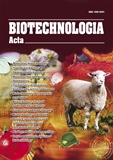SSN 2410-7751 (Print)
ISSN 2410-776X (Online)

Biotechnologia Acta Т. 18, No. 2, 2025
P. 110-113, Bibliography 6 , Engl.
UDC 615.262.1:615.454.1].07:616.147.17-007.64-085
doi: https://doi.org/10.15407/biotech18.02.110
EFFICACY OF COMBINED RECTAL CREAM “DILATIL” (DILTIAZEM/LIDOCAINE/METHYL-URACIL) IN PRE-CLINICAL STUDY ON A MODEL OF ACUTE COMPLICATED ANAL FISSURE IN COMPARISON WITH RECTAL CREAM NIFECAIN
G.V. Zaychenko, M.P. Tymofieiev
Pharmacology department of the Bogomolets National Medical University, Kyiv.
Aim: to assess efficacy of a new rectal cream “Dilatil” (diltiazem/lidocaine/methyluracil) (D) in pre-clinical study on a model of acute complicated anal fissure (ACAF) in compared to rectal cream “Nifecain” (nifedipine/lidocaine) (N).
Materials and Methods: animal model of anal fissure, macroscopic assessment, enzyme-linked immunosorbent assay, statistical Student’s and Wilcoxon’s tests.
Results: At the end of the study in the D group, the severity of the pathological process was statistically lower than in the Control pathology (CP) and N groups. Levels of IL-6, IL-10, and TNF-α in the homogenate of anodermal tissue (HAT) in the D group were significantly lower compared to CP. The level of IL-6 was significantly lower in the D group compared to N.
Conclusions: better efficacy of D vs N was observed in a pre-clinical study that was also confirmed by the level of IL-10 in HAT tissue at the end of the experiment.
Keywords. Rectal cream, anal fissure, Dilatil, Nifecain, macroscopic assessment, enzyme-linked immunosorbent assay, IL-10, IL-6, HIF-1α, TNF-α, calcium channel blockers, diltiazem.
© Palladin Institute of Biochemistry of the National Academy of Sciences of Ukraine, 2025
Reerebces
1. Noyes, A. D., Feleshtynskyy, Y. P., Pyrohovskyy, V. Y. (2021). Features of surgical treatment
of anal fissure combined with chronic hemorrhoids. Hospital surgery, 1(93), 77–82. https://doi.
org/10.11603/2414-4533.2021.l.12026
2. Davids, J. S., Hawkins, A. T., Bhama, A. R., Feinberg, A. E., Grieco, M. J., Lightner, A. L.,
Feingold, D. L., Paquette, I. M. (2023). The American Society of Colon and Rectal Surgeons Clinical
Practice Guidelines for the Management of Anal Fissures. Diseases of the colon & rectum, 66, 90–
99. https://doi.org/10.1097/DCR.0000000000002664
3. Emile, S. H., Elgendy, H., Elfeki, H., Magdy, A., Abdelmawla, A. A., Abdelnaby, M., Khafagy, W.
(2017). Does the duration of symptoms of anal fissure impact its response to conservative treatment?
A prospective cohort study. Int. J. Surg., 44, 64–71. https://doi.org/10.1016/j.ijsu.2017.06.044
4. Farouk, R., Duthie, G. S., MacGregor, A. B., Bartolo, M. S. (1994). Sustained internal sphincter
hypertonia in patients with chronic anal fissure. Dis. Colon. Rectum., 37(5), 424–433. https://doi.
org/10.1007/BF02076185
5. Lund, J. N., Binch, C., McGrath, J., Sparrow, R. A., Scholefield, J. H. (1999). Topographical
distribution of blood supply to the anal canal. Br. J. Surg., 86(4), 496–504. https://doi.org/10.1046/
j.1365-2168.1999.01026.x
6. Klosterhalfen, B., Vogel, P., Rixen, H., Mittermayer, Ch. (1989). Topography of the inferior rectal
artery: a possible cause of chronic, primary anal fissure. Dis. Colon. Rectum., 32(1), 43–52. https://
doi.org/10.1007/BF02554725

